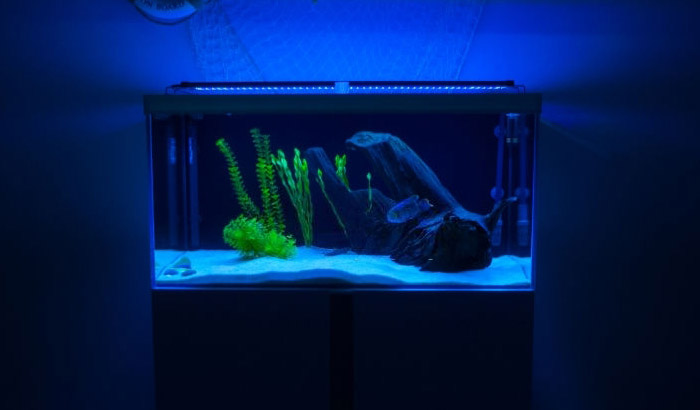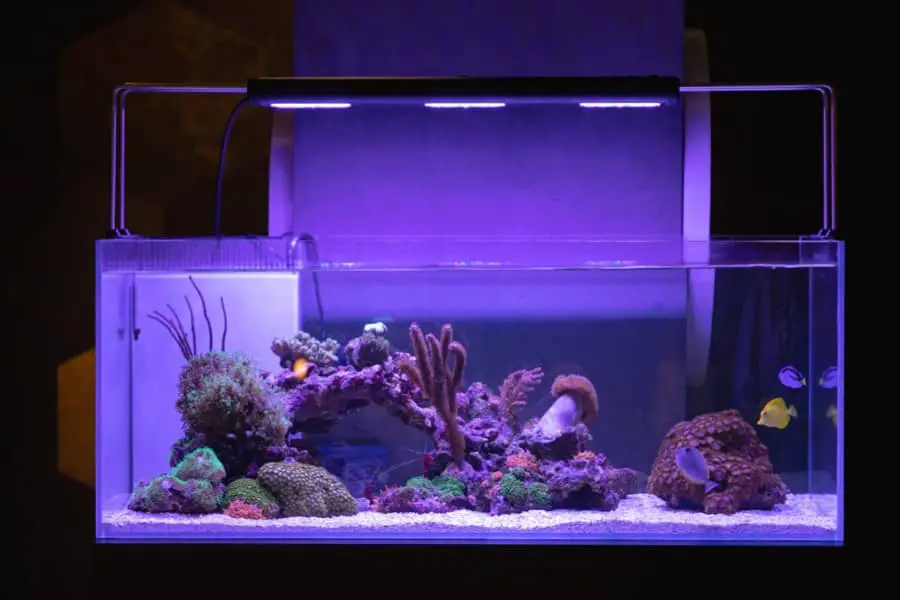Originally posted on May 22, 2023 @ 4:00 pm
Last Updated on 1 week by admin
Aquariums are a beautiful addition to any home or office, and they require proper care to maintain their beauty. One of the most debated topics in aquarium care is whether blue light is beneficial for aquarium plants. While some claim that blue light can enhance plant growth, others believe it can be harmful. So, is blue light good for aquarium plants? Let’s explore this topic in-depth to help you make an informed decision for your aquatic environment.
As an aquarium enthusiast, you must always strive to maintain a healthy and thriving ecosystem for your aquatic pets. The lighting you use in your aquarium plays a crucial role in achieving this goal. In this article, we will delve into the science behind blue light and its effects on aquarium plants, to help you understand whether it is beneficial or detrimental to your aquarium’s ecosystem.
Is Blue Light Good for Aquarium Plants?
Yes, blue light is beneficial for aquarium plants. Blue light has a wavelength that helps in photosynthesis and promotes plant growth. It is also known to enhance the color and pigment of the plants, making them look more vibrant and beautiful. However, it is important to note that too much blue light can cause algae growth, so it is essential to balance the light spectrum in your aquarium.

Is Blue Light Good for Aquarium Plants?
Aquarium plants are a vital element in any aquarium ecosystem. They provide oxygen, absorb carbon dioxide, and reduce the growth of algae. However, to thrive, aquarium plants require proper lighting conditions. Blue light is a popular choice among aquarium enthusiasts, but is it good for aquarium plants? Let’s find out.
What is Blue Light?
Blue light is a type of light in the visible spectrum with a wavelength between 400 to 490 nanometers. It is known for its high energy and is commonly used in aquarium lighting. Blue light is also prevalent in the natural environment, especially in the deeper parts of the ocean.
Blue light has a unique effect on aquarium plants. It helps to promote photosynthesis, which is the process by which plants convert light into energy. Blue light also enhances the coloration of aquarium plants and can help to prevent algae growth.
The Benefits of Blue Light for Aquarium Plants
There are several benefits of using blue light for aquarium plants. Firstly, blue light helps to promote photosynthesis, which is essential for the growth and vitality of aquarium plants. Secondly, blue light enhances the coloration of aquarium plants, making them more vibrant and attractive. Thirdly, blue light can help to prevent algae growth, which can be detrimental to aquarium plants.
Blue light is also beneficial for certain types of aquarium plants. For example, plants that originate from shallow waters with high light conditions benefit from blue light. Additionally, plants that have a blue pigment in their leaves, such as Ludwigia repens, benefit from blue light.
Blue Light vs Other Types of Light
While blue light is beneficial for aquarium plants, it is not the only type of light that plants require. Plants require a spectrum of light, including red and green light, to grow and thrive. Therefore, it is important to provide a balanced spectrum of light to aquarium plants.
Additionally, too much blue light can be harmful to aquarium plants. It can cause damage to the chlorophyll in the leaves, which can lead to stunted growth and yellowing of the leaves. Therefore, it is essential to provide the right intensity and duration of blue light to aquarium plants.
Providing Blue Light to Aquarium Plants
There are several ways to provide blue light to aquarium plants. One way is to use LED lights that are specifically designed for aquariums. These lights provide a balanced spectrum of light, including blue light, and are energy-efficient.
Another way to provide blue light to aquarium plants is to use blue light bulbs. These bulbs emit a high intensity of blue light and are suitable for plants that require high light conditions. However, it is important to use these bulbs in moderation to prevent damage to the plants.
Conclusion
In conclusion, blue light is good for aquarium plants. It helps to promote photosynthesis, enhances coloration, and can prevent algae growth. However, it is important to provide a balanced spectrum of light to aquarium plants and to use blue light in moderation to prevent damage to the plants. By providing the right lighting conditions, aquarium plants can thrive and contribute to a healthy aquarium ecosystem.
Frequently Asked Questions
In this section, we will answer some of the most common questions about whether blue light is good for aquarium plants or not.
What is Blue Light and How Does it Affect Aquarium Plants?
Blue light is a type of light that has a shorter wavelength than other colors in the visible spectrum. It is often used in aquarium lighting because it can enhance the coloration of fish and corals. However, when it comes to plants, blue light is not as beneficial as other colors like red and green. While blue light can promote photosynthesis in plants, it is not the most optimal wavelength for their growth. In fact, too much blue light can even be harmful to some types of plants.
Therefore, if you want to provide the best lighting for your aquarium plants, it is recommended to use a full-spectrum LED light that includes a range of colors, including red and green, in addition to blue.
Can Blue Light be Used as a Supplemental Light for Aquarium Plants?
Yes, blue light can be used as a supplemental light for aquarium plants, but it should not be the primary source of light. Plants need a balanced spectrum of light to grow and thrive, and blue light alone is not enough. However, some aquarium enthusiasts use blue light to enhance the coloration of their plants, as it can make them look more vibrant and healthy. If you want to use blue light as a supplemental light, it is recommended to use it in conjunction with a full-spectrum LED light that provides the necessary wavelengths for plant growth.
It is also important to note that not all plants require the same amount of light. Some plants, such as mosses and ferns, can thrive in low-light conditions, while others, such as high-demanding stem plants, require higher levels of light. Therefore, it is essential to research the lighting requirements of your specific plants before setting up your aquarium lighting.
Is Blue Light Harmful to Aquarium Plants?
While blue light is not necessarily harmful to aquarium plants, too much of it can be detrimental to their growth. As mentioned earlier, blue light is not the most optimal wavelength for plant growth, and too much of it can cause plants to become stunted or even die. Additionally, blue light can also promote the growth of algae, which can compete with plants for nutrients and light.
Therefore, it is recommended to use a balanced spectrum of light that includes other colors, such as red and green, to provide the best conditions for plant growth. If you notice that your plants are not thriving under your current lighting conditions, it may be necessary to adjust the spectrum or intensity of your aquarium lighting.
What are the Benefits of Using Full-Spectrum LED Lights for Aquarium Plants?
Full-spectrum LED lights provide a balanced spectrum of light that includes all the necessary wavelengths for plant growth. This means that they can promote healthy plant growth and development, as well as enhance the coloration of fish and corals. Additionally, LED lights are energy-efficient and long-lasting, making them a cost-effective option for aquarium lighting.
Using full-spectrum LED lights can also help to reduce the growth of algae in your aquarium, as they provide the necessary light for plants to outcompete algae for nutrients and light. Overall, using full-spectrum LED lights is the best way to provide optimal lighting conditions for your aquarium plants and create a healthy and vibrant aquatic environment.
How Much Light do Aquarium Plants Need?
The amount of light that aquarium plants need depends on the specific species of plants you have in your tank. Some plants, like mosses and ferns, can survive in low-light conditions, while others, like stem plants, require high levels of light to thrive. Generally, it is recommended to provide around 8-10 hours of light per day for aquarium plants, but this can vary depending on the type of plants you have and the intensity of your lighting.
It is also important to note that too much light can be just as harmful as too little. If you notice that your plants are not growing well or are showing signs of stress, it may be necessary to adjust the intensity or duration of your lighting. Regular monitoring of your plants and aquarium lighting is essential to ensure that your aquatic environment remains healthy and balanced.

Can I Leave The Blue Aquarium Light On All Night? The DANGER to Your Fish, & Risk of Algae Growth
In conclusion, the question of whether blue light is good for aquarium plants is a complex one. While blue light can stimulate plant growth and promote photosynthesis, it can also have negative effects on fish and other aquatic life in the tank.
Therefore, it’s important for aquarium owners to carefully consider the needs of both their plants and their fish before deciding to incorporate blue light into their tank setup. Consulting with a knowledgeable professional can also be helpful in making informed decisions about lighting for an aquarium.
Ultimately, the goal is to create a healthy and balanced environment for all inhabitants of the tank, including plants, fish, and other aquatic creatures. By carefully weighing the pros and cons of blue light and making informed decisions, aquarium owners can help their plants thrive while maintaining a safe and healthy ecosystem for all.
